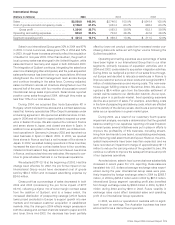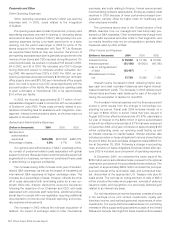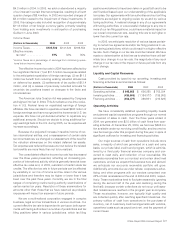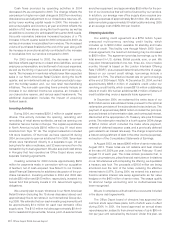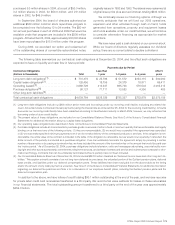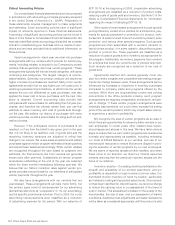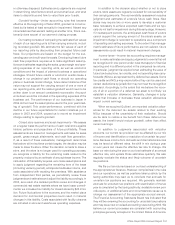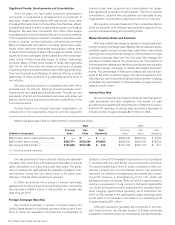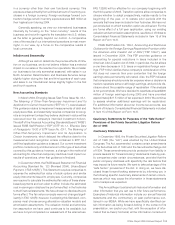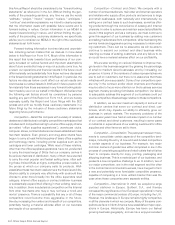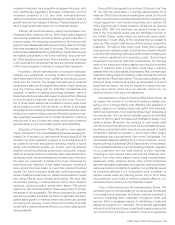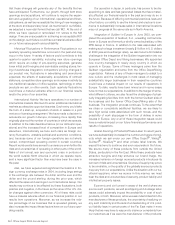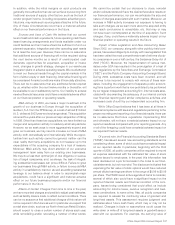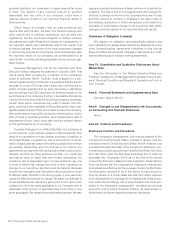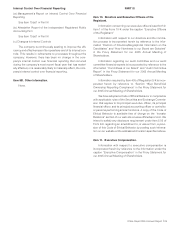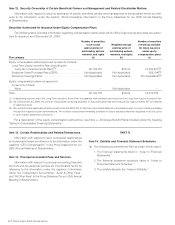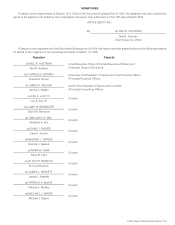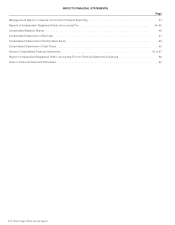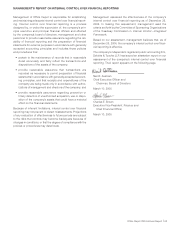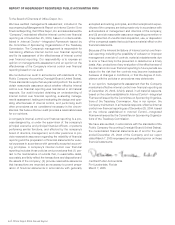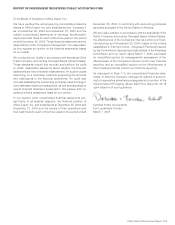Office Depot 2004 Annual Report Download - page 37
Download and view the complete annual report
Please find page 37 of the 2004 Office Depot annual report below. You can navigate through the pages in the report by either clicking on the pages listed below, or by using the keyword search tool below to find specific information within the annual report.margins in that area. As competition increases in Europe, both
from traditionally aggressive European companies, and the
increased presence of U.S. and other international/multi-
national competitors, we will be challenged to maintain both our
growth rates and our margins in Europe. These pressures could
have a material adverse impact on our financial results.
Internet: As mentioned above, many Internet-based mer-
chandisers also compete with us. While this industry segment
has recently sustained somewhat slower growth rates than in
previous years, the remaining competitors in the Internet-only
segment are substantially stronger and better able to compete
than was necessarily the case in the past. The stronger com-
petitors have established strong distribution capabilities and are
formidable competitors to the more traditional “brick and mor-
tar” office supplies superstores. This competition may increase
in the future as the companies that have survived the ‘shakeout’
in the Internet segment continue to expand their operations.
In addition, certain manufacturers of computer hardware,
software and peripherals, including certain of our suppliers,
have expanded their own direct marketing of products, partic-
ularly over the Internet. The largest manufacturer of personal
computers is also now the largest direct seller of such products
over the Internet, along with the attendant accessories and
supplies. In addition to selling technology hardware, some of
these manufacturers have also begun to expand their offerings
to include machine supplies, such as ink and toner. The num-
ber of these direct sellers has increased in recent years. Even
as we expand our own Internet efforts, our ability to anticipate
and adapt to the developing Internet marketplace and the capa-
bilities of our network infrastructure to efficiently handle our rap-
idly expanding operations are of critical importance. Failure to
execute well in any of these key areas could have a material
adverse effect on our future sales growth and profitability.
Execution of Expansion Plans: We plan to open approxi-
mately 100 stores in the United States and Canada and approx-
imately 5 to 10 stores in our International Group during 2005. We
consider our retail expansion program to be an integral part of
our plans to achieve anticipated operating results in future
years. Circumstances outside our control, such as adverse
weather conditions affecting construction schedules, unavail-
ability of acceptable sites or materials, labor disputes and sim-
ilar issues could impact anticipated store openings. At times in
the past, our expansion activities have been hampered by
sometimes poor selection of real estate locations, resulting in
some stores that have failed to meet their planned financial
results. Our future expansion plans also include opening retail
stores of different sizes than our traditional superstore models
and using different store formats and layouts. We have also
considered opening a retail presence within other retailer’s
locations, utilizing so-called “stores within stores.” We cannot
determine with certainty whether these newly sized or format-
ted stores will be successful. The failure to expand by opening
new stores as planned and/or the failure to generate the antic-
ipated sales growth in markets where new stores are opened
(including the opening of new sizes and formats of stores)
could have a material adverse effect on our future sales growth
and profitability.
During 2004, we agreed to purchase 124 stores from Toys
“R” Us, with the expectation of opening approximately 50 of
these as Office Depot stores and selling the others. By the end
of 2004, we had removed several stores from the transaction by
mutual agreement, sold several properties and opened 36
Office Depot stores in these locations; others will be opened
during 2005. With this purchase, we gained access to mar-
kets in the mid-Atlantic states and the Northeast corridor of
the United States, areas where we previously were under-
represented in retail. Many of the locations that we expect to
open as Office Depot retail stores will face strong competitive
pressures. Throughout their useful lives, these retail locations
must generate operating cash flows that are at least sufficient
to recover the remaining book value of the initial purchase price
and related capitalized and operating costs. Should these
stores fail to meet future cash flow expectations, the carrying
value of the stores and related assets may need to be written
down. If required, such a write down could have a material
adverse effect on future results of operations. Also, we have esti-
mated the selling value and holding costs of stores that will not
be opened as Office Depot stores. If we are unsuccessful in dis-
posing of these locations as quickly as anticipated or at price
levels that we expect, we may be required to adjust their car-
rying value which could have an adverse impact on our
reported results in the period of adjustment.
Cannibalization of Sales in Existing Office Depot Stores: As
we expand the number of our stores in existing markets, pur-
suing a ‘fill-in’ strategy that is both offensive and defensive in
nature, sales in our existing stores may suffer from cannibal-
ization (as customers of our existing stores begin shopping at
our new stores). Our new stores typically require an extended
period of time to reach the sales and profitability levels of our
existing stores. Moreover, the opening of new stores does
not ensure that those stores will ever be as profitable as exist-
ing stores, particularly when new stores are opened in highly
competitive markets or markets in which other office supply
superstores may have achieved “first mover” advantage. Our
comparable sales are affected by a number of factors, includ-
ing the opening of additional Office Depot stores; the expansion
of our contract business in new and existing markets; migration
of our customers from the retail channel to other channels,
including our own Internet, direct and contract channels, com-
petition from other office supply chains, mass merchandisers,
warehouse clubs, computer stores, other contract stationers
and Internet-based businesses; and regional, national and inter-
national economic conditions. In addition, our profitability would
be adversely affected if our competitors were to attempt to
capture market share by reducing prices. Any or all of these
circumstances could have a material adverse effect on our
anticipated future revenue and profitability models.
Costs of Remodeling and Re-merchandising Stores: The
remodeling and re-merchandising of our stores has contributed
to increased store expenses, and these costs are expected to
continue impacting store expenses throughout 2005 and
beyond. While a necessary aspect of maintaining a fresh and
appealing image to our customers, the expenses associated
with such activities could have a significant negative impact on
our net income in the future. In addition, there is no guarantee
Office Depot 2004 Annual Report |35


